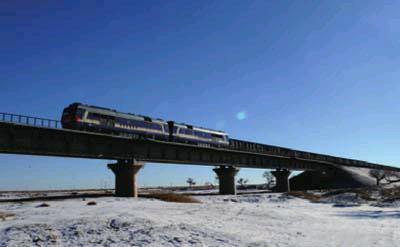Raising Awareness
2016-01-06
Middle school students in Hefei, capital of east Chinas Anhui Province, form a red ribbon on November 30 to mark World AIDS Day, which falls on December 1.
As of the end of October, China reported 575,000 carriers and AIDS patients, according to the China Center for Disease Control and Prevention.
Agri-Investment
The Ministry of Finance said on December 1 that China will spend 20.36 billion yuan ($3.18 billion) on programs for developing modern agriculture this year.
The funds are used to support leading industries with local characteristics in rural areas, promote the moderate scale management of land and adjust the agricultural structure.
The Chinese Government unveiled a rural reform plan in early November, stressing that agricultural management and rural collective property rights will both be improved by 2020 to safeguard grain security and raise the income of farmers.
China has witnessed substantial improvements to rural development over the past few decades with yields of summer grain reaching a record high in 2015 after increasing for 11 straight years.
Fighting Pollution
China has fulfilled the targets for reducing major pollutants outlined in its 12th Five-Year Plan (2011-15), six months ahead of schedule, Minister of Environmental Protection Chen Jining said on November 29.
Nonetheless, a substantial improvement of the environment will only be possible if pollution is reduced by a further 30 to 50 percent, he said.
According to Chen, by 2014 discharge of sulfur dioxide and Chemical Oxygen Demand (COD), a measure of organic pollutants in water, had dropped by 12.9 and 10.1 percent, respectively, from 2010 levels. Emissions of ammonia nitrogen and nitrogen oxide had also declined by 9.8 and 8.6 percent, respectively.
Discharges of the four major pollutants continued to drop in the first half of this year, Chen said.
China vowed to cut COD and sulfur dioxide emissions by 8 percent and ammonia nitrogen and nitrogen oxide emissions by 10 percent by 2015 compared with 2010 levels.
Chen also noted that the surface area affected by acid rain in China had shrunk to 1990s levels, while water quality had improved significantly.
China has phased out some 250,000 tonnes of ozone-depleting substances during the same period, he said. This is more than half of the total amount phased out by all developing countries.
The minister warned, however, some 20 million tonnes of major pollutants are still discharged annually in China, and that figure must be reduced by another 30 to 50 percent.
Vocational Education
An interim evaluation published on December 2 showed China has increased the amount of money going into vocational education, with good results in the past five years.
Statistics show that in 2014, the countrys input into secondary and higher vocational education was 190.7 billion yuan ($29.81 billion) and 151.8 billion yuan ($23.73 billion), respectively, increasing by 59.02 and 64.78 percent, respectively compared to 2009.
Published by the Ministry of Education on Chinas National Plan for Medium and Long-Term Education Reform and Development(2010-20), the evaluation report specifically focuses on vocational education in China.
Around 91.5 percent of students in secondary vocational schools from rural areas or families with financial difficulties are enjoying tuition-free education, while 40 percent of them receive an annual 2,000-yuan ($313) education grant from the government.
The employment rate of secondary vocational school graduates has been above 95 percent for five years in a row, and the number for higher vocational schools reached 91.5 percent in 2014, making vocational schools an important base for technical personnel.
Improving Services
China will cut more red tape to improve the quality and efficiency of public services, according to a circular on public service and entrepreneurship published by the General Office of the State Council, Chinas cabinet, on November 27.
The document outlines the goals of optimizing service delivery and encouraging grassroots entrepreneurship.
It states that governments at all levels and their departments should issue a list of the public services they provide as well as a guide to each of the services for citizens. These should then be made available to the public through government websites or brochures.
Authorities at all levels will further simplify procedures and encourage innovation in their methods of service in order to shorten processing times, while local governments should support the development of more one-stop service centers.
New TCM Services
China is planning more and better nonprofit hospitals specializing in traditional Chinese medicine (TCM) in a bid to rapidly develop the countrys TCM industry.
A comprehensive reform will focus on state-owned TCM hospitals at county and city levels to strengthen their nonprofit nature while helping them to “better serve the people,” according to a document jointly released on November 27 by the National Health and Family Planning Commission and the State Administration of Traditional Chinese Medicine.
The document promises “greater support” for the development and innovation of the TCM industry, encouraging local TCM service providers to take the lead in exploring new management and operation systems catering to TCM.
It sets the goal that each city and county should have at least one public TCM hospital, and these hospitals should have more business cooperation and personnel exchanges with the ones owned by other individuals and groups.
Health institutions specializing in medicine traditionally used by ethnic minority groups are also included in the reform and will receive equal backing.
Top Universities
The Times Higher Education on December 2 published the 2016 rankings of the worlds best universities in emerging economies, with Chinese universities taking 39 places in the top 200.
Universities from 35 countries are listed in the latest report. These countries are classified as emerging economies, including the BRICS nations of Brazil, Russia, India, China and South Africa.
China is the most-represented nation in the rankings, as five Chinese institutions make the top 10, including Peking University and Tsinghua University at the top two spots.
The recognition is based on 13 performance indicators used to create the annual Times Higher Education World University Rankings, but are specially calibrated to reflect the development priorities of universities in emerging economies.
Salt Lake Data Center
Northwest Chinas Qinghai Province plans to build the worlds first salt lake data center to serve domestic resource planning and provide technical support to other countries.
The center in Xining, the provincial capital, will take eight years to complete with a total investment of 90 million yuan ($14 million), said Wang Jianping, head of the project under the Salt Lakes Institute of the Chinese Academy of Sciences.
Wang explained that the first phase of construction from 2016 to 2018 will adopt big data and cloudcomputing technology to process data about the lakes. The center will also launch a website for related tourism.
Qinghai boasts the countrys largest salt lake, Qarhan Salt Lake, which covers more than 5,000 square km on the southern edge of the Qaidam Basin.
China has more than 1,000 salt lakes, located mainly in Qinghai as well as Xinjiang Uygur, Tibet and Inner Mongolia autonomous regions.
Oldest Panda
A keeper puts a crown on the head of giant panda Basi at a ceremony in the Panda Research and Exchange Center in Fuzhou, Fujian Province on November 28 to celebrate her 35th birthday, which roughly equals 130 years in human age.
Born in 1980, Basi is currently the oldest living panda in the world. In 1990, she was chosen as the prototype for Pan Pan, the mascot for the Beijing Asian Games.
The New Jet
A China-developed ARJ21 aircraft is parked at the Shuangliu International Airport in Chengdu, Sichuan Province, after it was delivered to Chengdu Airlines by its producer, the Commercial Aircraft Corp. of China, Ltd., on November 29. The regional liner is the first of the model to commence commercial operation worldwide.
PMI Data
Chinas factory activity hit a 39-month low in November as domestic and international demand remained sluggish while the service sector shone, official data showed.
The manufacturing purchasing managers index (PMI) came in at 49.6 in the month, down from 49.8 in October, according to statistics released by the National Bureau of Statistics(NBS) and the China Federation of Logistics and Purchasing(CFLP) on December 1.
A reading above 50 indicates expansion, while anything below 50 represents contraction.
The production sub-index posted a reading of 51.9, down from 52.2 in October. The sub- index for new orders came in at 49.8, back in contraction territory after posting 50.3 in the previous month.
NBS statistician Zhao Qinghe cited tepid domestic and international demand as well as the usual reduction in production seen during winter.
On the bright side, nonmanufacturing activity improved in November, signifying that the service sector was stepping up to take a stronger role in boosting the economy.
The PMI for the non-manufacturing sector, which tracks the business activities of the service and construction industries, rose to 53.6 from 53.1 in October.
Logistics, including post and courier services, accelerated in the month thanks to annual largest online shopping event on November 11.
Retail and wholesale business, as well as services such as Internet software, banking, securities trading and insurance, all saw strong expansion from the previous month.
IPO Resumption
China resumed initial public offerings (IPOs) on November 30 with an industrial explosives maker becoming the first to offer shares to investors following a four-month freeze.
The China Securities Regulatory Commission (CSRC) froze IPOs in July as part of efforts to slow a market rout, but the countrys stock market has since become more stable. The resump- tion of IPOs was announced in a statement on November 20.
Shares of Shenzhen-listed Hubei Kailong Chemical Group Co. Ltd., the first of the 10 firms to go public, were priced at 28.68 yuan ($4.48). The remaining nine companies went public on December 1-2.
Anti-Dumping Fines
Chinas Ministry of Commerce announced on December 1 that it will impose anti-dumping measures on methyl methacrylate(MMA) imported from Singapore, Thailand and Japan.
The final ruling requires importers of the product to place deposits with Customs authorities ranging from 6.7 percent to 34.6 percent of the imports starting from December 1.
Companies from the abovementioned countries had dumped the chemical into the Chinese market and such imports caused substantial damage to the domestic industry, according to the document.
The ministry launched an anti-dumping probe into imported MMA from the three countries in August 2014 and issued a preliminary ruling on July 24.
MMA is an organic compound that can be used to produce glass, plastic, paint and adhesives.
Better Connected
A fully loaded train sets off from Ejin Banner, north Chinas Inner Mongolia Autonomous Region, to Hami, northwest Chinas Xinjiang Uygur Autonomous Region, on December 1. A train route connecting the two regions was put into use on the day.
Electricity Reform
China released documents on November 30 on the electricity sector reforms covering everything from pricing to setting up a national electricity futures market. The new pricing system, which was piloted in Shenzhen, south Chinas Guangdong Province, and Inner Mongolia Autonomous Region early this year, will be expanded to Anhui, Hubei, Yunnan, and Guizhou provinces and Ningxia Hui Autonomous Region, according to one of the six documents jointly published by the National Energy Administration and the National Development and Reform Commission.
The new pricing system aims to benefit power users, set up a cost-saving mechanism for power grid enterprises and promote the marketization of electricity.
China will establish electricity trading bodies that are “relatively independent” to promote interprovincial trade. Authorities will explore the possibility of a unified national electricity futures and derivatives market, according to the documents.
Power users who “meet the requirement for market access”can directly buy from power generation companies, the documents said.
China will gradually scrap government control of on-grid prices in areas with a mature electricity market, letting the market and consumers set the price, according to the documents.
Innovative Firms
Chinese companies clinched three spots in the Boston Consulting Groups 10th annual global survey of the 50 most innovative companies released on December 2.
The group published a ranking of the 50 most innovative companies in the world based on the survey of 1,500 executives. Apple, Google and Tesla Motors are the top three on the list.
Chinese online media company Tencent is number 12, and Huawei and Lenovo rank 45 and 50, respectively. This is an increase from a decade ago, when there were no Chinese companies on the list, the reports co-author Andrew Taylor said.
A global group is comprised of the following: 29 companies from the United States, 11 from Europe and 10 from Asia.
According to the survey, innovation has gained increasing importance in corporate success. About 79 percent of the survey respondents ranked innovation as either the top priority or a top-three priority at their companies, the highest percentage since the question was asked in 2005.
Meanwhile, science and technology continue to be seen as increasingly important underpinnings of innovation, enabling four attributes that many executives identify as critical: an emphasis on speed, well-run research and development processes, the use of technological platforms, and the systematic exploration of adjacent markets.
Policy Supports
China will aim to establish a number of internationally competitive agricultural firms by 2020, the State Council, Chinas cabinet, said on December 1.
It released a set of guidelines on land reclamation reforms, saying that “by restructuring reclamation areas and innovating in the operation mechanisms of farms, a number of large-scale agricultural groups will emerge, which are effectively managed and adaptable to the market economy.”
“The reforms on land reclamation are not only important to national food security and the development of modern agriculture, but also crucial for China to compete with multinationals in the agricultural field,” said Han Changfu, Minister of Agriculture.
The guidelines also encourage Chinese reclamation firms to step out of the country through establishing joint ventures with foreign companies or conducting mergers and acquisitions, and stress the importance of introducing advanced technology and management mechanisms to domestic firms.
Power Transportation
The first converter transformer weighing 285 tons is loaded before being delivered to a converter station in Shaoxing, east Chinas Zhejiang Province, on December 1.
The station is part of a 1,700-km ultrahigh-voltage direct current transmission project, which will transfer 8,000 megawatts of power from Lingzhou in Ningxia Hui Autonomous Region to Shaoxing.
Power of a Light Metal
Workers test aluminum that is used to make cans in Zouping County, east Chinas Shandong Province, on December 2. The county has been actively cultivating a strong aluminum industry.
